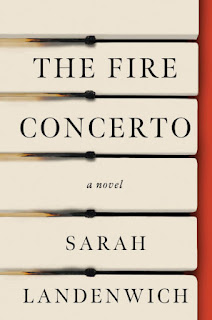 period. She lives in Louisville, Kentucky with her husband and daughter.
period. She lives in Louisville, Kentucky with her husband and daughter.
Landenwich applied the Page 69 Test to The Fire Concerto with the following results:
From page 69:Visit Sarah Landenwich's website.A growing disquiet was stirring in Clara's stomach. From the moment she heard the metronome accelerate ahead of the grandfather clock, a memory had been inching to the surface of her mind: Madame in the gallery, crossing out the metronome marking on Starza's Dark Angel Sonata with a lash of her pencil. Madame, who held sacred a composer's original intent the way Constitutionalists revered the Founding Fathers, scribbling in a new tempo. To Clara's look of incredulity, Madame had offered only the simplest of explanations. It is too fast, she had said. His metronome was not right.Page 69 of The Fire Concerto falls in chapter 6, one of my favorite chapters of the book. Earlier in the novel, my protagonist, Clara, a famous pianist before she suffered career-ending injuries in a fire, inherits a mysterious metronome from her deceased piano teacher, a formidable woman Clara calls “Madame.” In this chapter, Clara and her friend Julián have taken the metronome to an antiques store for evaluation. Clara is realizing that the metronome has a unique time anomaly akin to that of a metronome that belonged to a famous Romantic composer, Aleksander Starza. It is here that Clara understands that the metronome in her possession may in fact be Starza’s long-lost metronome, a valuable object thought to have been destroyed over a hundred years ago, after the composer’s 1885 murder at the hands of one of his pupils, a brilliant female pianist named Constantia Pleyel.
I’d give the Page 69 Test a 90% accuracy rating for The Fire Concerto. This page marks the beginning of a critical reveal in the novel, one that propels my protagonist more deeply into the mystery of why she has been given this unusual bequest. The story is largely happening in the present, but the past—both the distant past of the composer as well as Clara’s own past as a musician with a complicated relationship with her teacher—are always near the surface, influencing the actions Clara takes.
Page 69 is also reflective of the way this book is full of fascinating (to me, anyway!) specialized information—how metronomes work, ways to identify a counterfeit million-dollar violin, bizarre 19th-century treatments for injuries (a bath in some tea and brandy, anyone?), just to name a few. I took great care to contextualize this technical information in accessible packaging—usually through dialogue—so it’s delivered to the reader in digestible and entertaining ways. On page 69, Clara and Julián talk about the metronome’s sordid past in the playful banter that characterizes their friendship. After Clara tells him the history of Starza’s murder, Julián responds with his typical effusiveness: “Holy sh**!” Julián raised both arms to the ceiling like a football player who had scored a touchdown. “I told you the thing was haunted!”
Later on page 69 and going into page 70, the reader receives the “full” story of Starza’s murder at the hands of the shadowy figure Constantia Pleyel—the official full story, anyway….
--Marshal Zeringue





